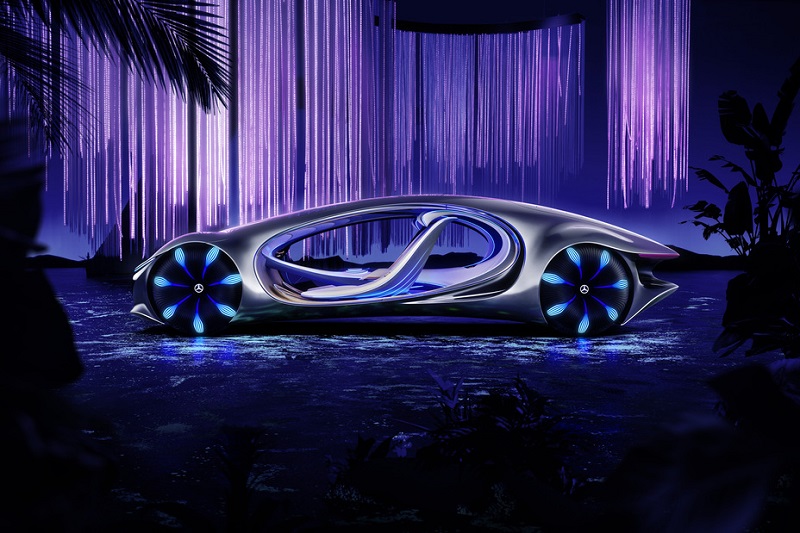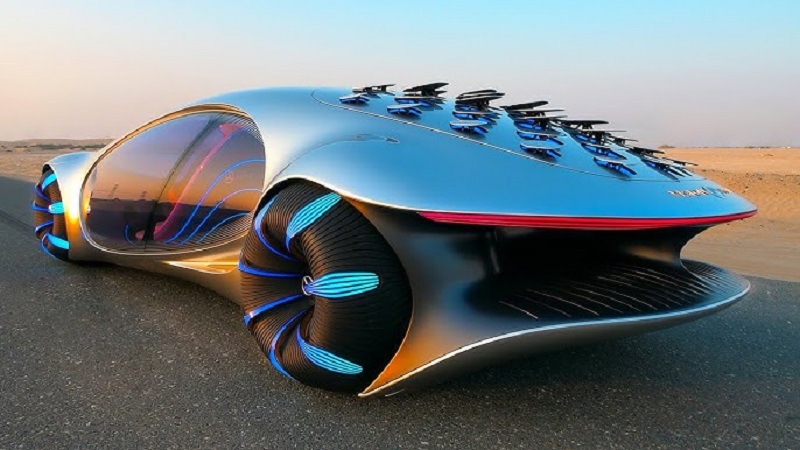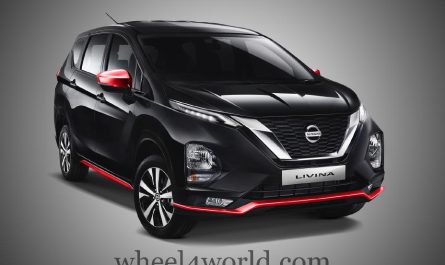Mercedes Vision AVTR (Advanced Vehicle Transformation) is an audacious step towards the sustainability and design of automobiles in the future. This concept car, which debuted at CES 2020, was inspired by James Cameron’s hugely successful film Avatar. It shows how modern transportation might coexist peacefully with the environment, cutting-edge science, and interpersonal relationships. Beyond traditional automobiles, the Vision AVTR offers a completely fresh perspective on user experience, automotive design, and environmental sustainability.
Read more: Maruti Swift LXi
The Inspiration: Avatar and Symbiosis with Nature
Mercedes-Benz’s goal for a sustainable, mutually beneficial interaction between humans, machines, and the environment is symbolized by the goal AVTR, which is more than just an automobile. The Avatar universe’s fundamental notion of harmony between technology and nature is the basis of this concept’s design philosophy. The Mercedes Vision AVTR aims to make the idealized world of James Cameron’s film—one in which people and environment coexist in perfect harmony—a reality.

Like the people in Avatar who use neural networks to connect with nature, this futuristic automobile is meant to interact with its surroundings. The car exhibits a symbiotic relationship in multiple dimensions, such as its environmentally conscious materials and its smooth operation in conjunction with the driver.
Design: A Truly Organic Form
The Mercedes Vision AVTR’s organic, flowing form immediately draws your attention because it is unlike any other car on the road today. Its streamlined, flowing shape gives it an almost animalistic appearance. The vehicle has the appearance of being alive, breathing in tandem with its occupants and surroundings. Its back has thirty-three independently movable “bionic flaps,” which resemble scales. In addition to improving the car’s aerodynamic efficiency, these flaps indicate that the vehicle is aware of its surroundings and adjusts its speed accordingly.
In addition, the Vision AVTR has a sleek, transparent interior that offers 360-degree visibility and blends in well with the surroundings. The car’s unique extraterrestrial appearance, enhanced by its transparent doors, curved, smooth exterior, and lighting features, is further associated with the Avatar concept.
Sustainability: The Core of Vision AVTR
A dedication to sustainability is key to the Vision AVTR’s design. 100% recyclable materials that are sourced sustainably to ensure minimal environmental impact are used in the construction of the vehicle. The vegan leather used to cover the seats is composed of Dinamica, a microfiber cloth derived from waste products. Furthermore, certain interior elements of the Vision AVTR are made of Karuun®, a fast-growing variety of rattan wood. This organic material complements the vehicle’s overall sustainable luxury motif and is environmentally friendly.
Battery Technology: The Power of Graphene
The innovative battery technology of the Vision AVTR is one of its most notable characteristics. The car runs on an organic cell battery made of graphene, which is devoid of hazardous substances and rare earth metals. In comparison to the lithium-ion batteries found in the majority of electric vehicles today, this breakthrough represents a considerable shift. The battery may be fully recycled and charges significantly more quickly, resulting in quicker energy replenishment.
With a capacity of more than 110 kWh, the Vision AVTR’s battery can travel more than 700 kilometers, or about 435 miles, between charges. This concept car is not only extremely efficient but also environmentally beneficial because to its regenerative braking system and sophisticated energy management, which also help to increase the range.
User Experience: A Mind-Controlled Interface
The Vision AVTR’s innovative control mechanism, which does away with conventional steering wheels and pedals, is arguably its most revolutionary feature. Rather, the vehicle is operated by biometric communication. The driver may operate multiple functions by simply touching a central control unit, which has the appearance of a beating heart. Based on the driver’s needs, the car scans the user’s biometric information and modifies the temperature, entertainment selections, and driving style.
The vehicle also has a cutting-edge mind-control interface. This technology allows drivers to control particular features of the vehicle and its environment utilizing brain-computer interaction (BCI). The car’s sensors track the driver’s mental activity so they can follow instructions just by thinking about them.
Autonomous Driving and Safety Features
Being totally autonomous means that the Vision AVTR can drive and navigate on its own without assistance from a human. Nevertheless, the AVTR integrates an intuitive connection between the vehicle and the occupant, in contrast to many other contemporary autonomous vehicles. The vehicle picks up on its occupants’ driving styles and habits through observation. Top focus is given to safety, and the Vision AVTR is outfitted with state-of-the-art sensors that continuously scan the surroundings to make sure it stays clear of obstructions and proactively adapts to the road’s circumstances.

Exterior and Interior Features
Exterior Design
- 33 “bionic flaps” resembling reptilian scales
- Organic, flowing design inspired by nature
- Illuminated wheels that signal motion and direction
- Transparent doors offering a seamless connection to the outside world
Interior Features
- Vegan leather seats made from sustainable Dinamica microfibre
- Karuun® wood detailing, symbolizing eco-consciousness
- Transparent, panoramic roof allowing natural light to flow into the cabin
- Central control unit that replaces the conventional steering wheel
Table: Key Features of Mercedes Vision AVTR
| Feature | Description |
|---|---|
| Design Inspiration | Avatar-themed, focusing on harmony with nature |
| Bionic Flaps | 33 movable flaps for aerodynamics and environmental interaction |
| Battery Technology | Graphene-based, fully recyclable, 110 kWh battery |
| Range | 700 km (435 miles) |
| Materials | Vegan leather, Dinamica microfiber, Karuun® wood |
| Autonomy Level | Fully autonomous driving |
| Control System | Biometric and brain-computer interface (BCI) |
| Interior | Transparent design, eco-friendly materials |
| Mind-Control Technology | Allows control of functions through thought processes |
| Charging Time | Ultra-fast charging, significantly quicker than standard EVs |
| Regenerative Braking | Extends range by capturing energy during braking |
Mercedes Vision AVTR Price in India
Since the Vision AVTR is a concept vehicle, it is not available for commercial sale yet. However, if the technology from this concept car makes its way to production models, the price is expected to be in the ultra-luxury segment, comparable to other high-end electric vehicles from Mercedes-Benz.
For a rough estimate, based on its advanced features, sustainability technologies, and futuristic design, the price of a potential production version of the Vision AVTR in India could range upwards of ₹2 crore to ₹5 crore (approx. USD 240,000 to USD 600,000), aligning it with other luxury electric vehicles like the Mercedes EQS. However, exact pricing would depend on the inclusion of autonomous driving features and the graphene battery technology.
Read more: Swift 2025: Everything You Need to Know About the Upcoming Maruti Suzuki Model
Conclusion: A Glimpse into the Future
The Mercedes Vision AVTR is a concept car, but it also symbolizes the direction that transportation is headed. It demonstrates the possibility of a peaceful coexistence of technology, people, and the environment with its environmentally friendly design, state-of-the-art battery technology, and mind-controlled user interface. Though it isn’t on sale just yet, its cutting-edge features give us an idea of what the car industry might bring us in the years to come.


